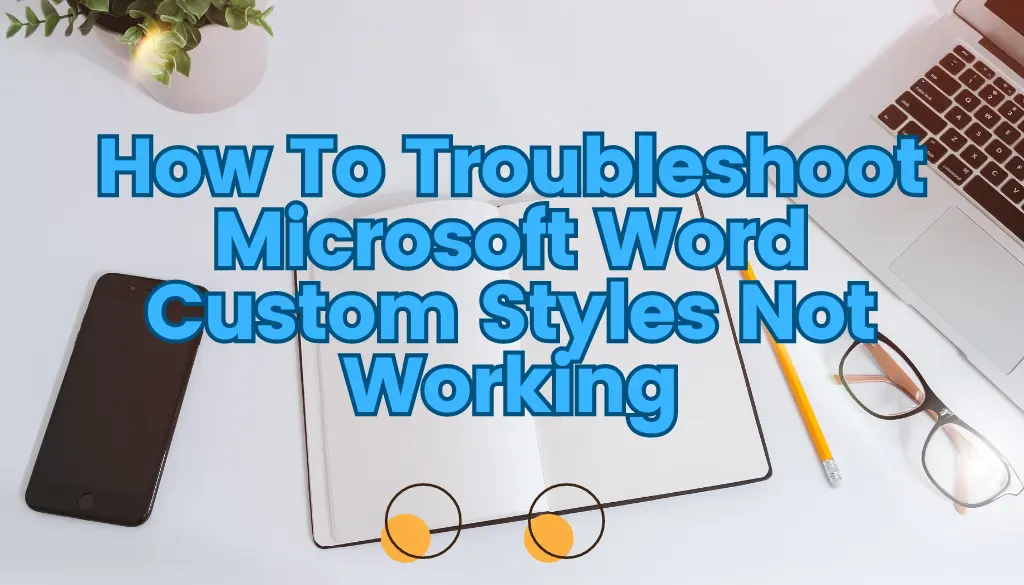If you’re frequently using Microsoft Word for your documents, you might have discovered the power of custom styles. These allow you to create a unique look for your text and make your document stand out. However, what happens when you face the frustrating issue of Microsoft Word custom styles not working? This problem can disrupt your workflow and make your beautifully designed documents look unprofessional.
In this article, we will dive into understanding what custom styles are, their benefits, and the common reasons why you might experience issues with them. Additionally, we will provide effective solutions to troubleshoot the problem, ensuring that you can create flawless documents without any hiccups. Whether it’s checking your style settings or implementing best practices, we’ve got you covered. So, let’s explore how to get your Microsoft Word custom styles back on track!
Understanding Microsoft Word Custom Styles
A. Definition of Custom Styles in Microsoft Word
Custom styles in Microsoft Word are unique formatting options that you can apply to text or paragraphs in your documents. These styles allow you to maintain a consistent look throughout your work. Instead of changing the font, size, color, and spacing for each section, you can create a custom style once, and then apply it wherever you need it.
There are two main types of custom styles:
1. Paragraph Styles: These styles apply to entire paragraphs, meaning everything from the font to the spacing is directly adjusted with a single click.
2. Character Styles: These styles are used to format individual words or phrases, letting you change font styles without altering the surrounding text.
Using custom styles helps create professional and organized documents, making it easier to manage the visual appeal of your content.
B. Common Applications and Benefits of Using Custom Styles
Custom styles enhance your workflow in several ways. Here are some common applications and benefits:
– Ease of Formatting: Instead of adjusting settings manually for each section, you can apply styles, saving you valuable time.
– Consistency: With custom styles, you ensure that every heading, subheading, and body text follows the same formatting rules, which makes your document look polished.
– Quick Changes: If you decide to change a style (for example, the font color of all headings), you can modify it in one place. All text that uses that style will update automatically.
– Professional Presentation: Well-organized documents appear more credible and are easier to read and comprehend. This is particularly important in business and academic settings.
– Navigation and Outlining: Using styles helps create a structured outline for your document, making it easier to navigate through sections. You can generate a table of contents quickly, thanks to the styles you’ve applied.
These benefits showcase why understanding and utilizing custom styles is essential for effective document creation.
C. Reasons Why Users May Encounter Issues with Custom Styles
Despite the advantages of custom styles, users may still face challenges. Here are some common reasons why Microsoft Word custom styles might not be working:
1. Document Corruption: Sometimes, the document may get corrupted, affecting the styles applied to it. A corrupt file may cause styles to behave unpredictably or not apply at all.
2. Improper Style Application: Users may apply styles incorrectly or overlook the necessary formatting settings, leading to inconsistent results.
3. Updates and Compatibility: If your version of Microsoft Word is outdated, it might not support the latest features, causing problems with custom styles. Additionally, opening documents created in different versions can result in style issues.
4. Change in Normal Template: If you have altered the Normal template (the base for new documents), it can affect how your custom styles perform, leading to unexpected outcomes.
5. Conflicting Styles: If multiple styles are applied to the same paragraph or text, it can lead to conflicts, making the document appear chaotic and disorganized.
6. Feature Limitations: Occasionally, certain features, such as Live Preview or document formatting options, may be disabled, affecting style functionality.

By understanding these common pitfalls, users can troubleshoot and resolve issues with Microsoft Word custom styles not working.
C. Summary Table of Custom Styles Issues
| Issue | Description | Potential Fixes |
|---|---|---|
| Document Corruption | File with corrupted elements affecting styles. | Try opening the document in a different version or restoring from backup. |
| Improper Application | Styles applied incorrectly or inconsistently. | Review and reapply the correct custom styles. |
| Outdated Software | Not using the latest version of Microsoft Word. | Update Microsoft Word to the latest version. |
| Change in Normal Template | Changes affect how styles are displayed. | Restore default settings or create new styles. |
| Conflicting Styles | Multiple styles applied leading to confusion. | Clear formatting and apply the desired style again. |
| Feature Limitations | Disabled features causing style changes. | Enable required features in settings. |
This understanding will set the stage for addressing issues that arise, focusing on effective solutions to ensure the smooth use of Microsoft Word custom styles.
Effective Solutions for Troubleshooting Microsoft Word Custom Styles
When your Microsoft Word custom styles not working, it can be frustrating. Thankfully, there are effective solutions to help you identify and resolve these issues. In this section, we will explore a step-by-step guide for troubleshooting your custom styles. We’ll also provide tips for preventing future problems with your styles, ensuring a smoother experience while using Microsoft Word.
1. Step-by-Step Guide to Identify and Resolve Custom Styles Not Working
Here’s a straightforward approach for troubleshooting your custom styles:
1.1 Checking Style Settings and Options
- Open the Styles Pane: Go to the Home tab and click on the small arrow in the corner of the Styles group. This opens the Styles Pane. Here, you can see all available styles, including your custom ones.
- Inspect Style Definitions: Locate your custom style and check if its settings are as you intended. Right-click on the style and select “Modify.” This opens a dialog where you can adjust font, size, color, and other settings.
- Check for Overrides: Sometimes, custom styles may not apply due to local formatting. Highlight the text you are having issues with, then select Clear Formatting from the Home tab (the button with an eraser icon). After clearing, apply your custom style again.
- View Style Usage: In the Styles Pane, look for styles marked with a down arrow. This indicates local formatting. To solve this, make sure to revert to the original style settings.
1.2 Ensuring Compatibility with Document Formats
Document formats can affect how custom styles function:
- Check File Type: If you’re using an incompatible format (like .txt or .rtf), this can disrupt your custom styles. Ideally, you should work with .docx or .dotx formats, as they are best suited for full functionality.
- Convert Document: If your document is in an old format (like .doc), consider converting it to .docx. You can do this by choosing “Save As” and selecting the .docx format. This can often restore functionality to your custom styles.
2. Tips for Preventing Future Issues with Custom Styles
To help avoid problems with Microsoft Word custom styles not working, consider these practical tips:
2.1 Keeping Microsoft Word Updated
Regular updates can provide fixes and improvements:
- Enable Automatic Updates: Go to File > Account, then check for updates. Enabling automatic updates ensures you receive the latest version without needing to remember manually.
- Check for New Features: Often, newer versions of Microsoft Word introduce new features and enhancements that can improve how custom styles behave. Stay abreast of these changes for smoother usage.
- Repair Installation: If you still experience issues after updates, use the “Repair” option in your installation settings. This can fix corrupted files causing custom style problems.
2.2 Best Practices for Creating and Managing Custom Styles
Creating and managing your custom styles well is crucial:
- Use Descriptive Names: When creating styles, use names that describe the style’s purpose (e.g., “Header 1 – Section Titles”). This helps to avoid confusion later.
- Limit Number of Custom Styles: Having too many styles can lead to confusion. Try to keep the number manageable and consistently used throughout your document.
- Establish a Style Guide: If you work with a team, a style guide helps everyone use custom styles consistently, minimizing compatibility issues.
3. Additional Resources
For further assistance in troubleshooting Microsoft Word custom styles not working, consider checking out the following resources:
- Microsoft Word Support for articles directly from Microsoft on styles and formatting.
- GCFGlobal: Microsoft Word Tutorials for step-by-step guides and tutorials on custom styles.
- LinkedIn Learning for professional courses on mastering Microsoft Word.
By following these steps and tips, you can successfully troubleshoot the issues with your custom styles, making your document creation process much smoother. With consistency and careful management, your custom styles can enhance your Word documents effectively.
Conclusion
Troubleshooting Microsoft Word custom styles not working can seem daunting, but with the right approach, it can be easily managed. Understanding what custom styles are and the common benefits they offer is essential for maximizing your experience in Microsoft Word. As we discussed, users often face issues with custom styles due to various reasons, such as incorrect style settings or incompatibility with document formats.
Following the step-by-step guide outlined in this article can help you identify and resolve these issues effectively. Remember to check your style settings and options meticulously, as even minor errors can lead to significant problems. Additionally, ensuring compatibility with your document’s format can prevent many headaches down the line.
To ensure that you do not encounter problems in the future, it is crucial to keep your software updated. Regular updates can fix bugs and enhance features, making your overall experience smoother. Lastly, adopting best practices for creating and managing your custom styles will help maintain their functionality, providing you with the consistent results you expect.

